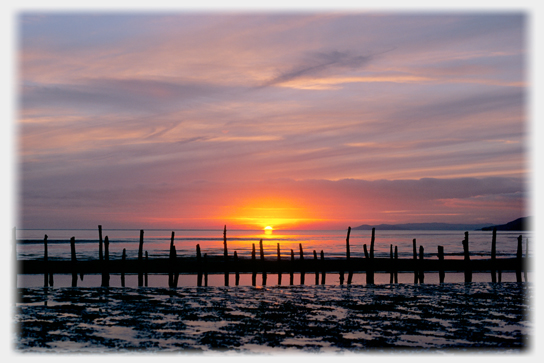
|
The Horizon
Horizons are alluring, evocative, tantalising. They beckon us, offering intrigue as to the novelty beyond them. They fire our imaginations with an unknown which is just sufficiently different form the known not to be threatening. And they fascinate us with that which can never be reached. They are at once within nature and beyond her. This richness, and its frequent beauty, seem due to the way horizons mix the unattainable in our imagination with the familiar natural world. The horizon I see from here is absolutely concrete and public - we can walk towards it together, but equally there is always a horizon we have not reached.
Horizons call to us, pulling at longings within us. Longings which are often buried deep, over which we pass like a swimmer on the water's surface, not quite admitting a little unease at what might lie below. And that uncertainty creates the tension, the frisson, that is the essence of horizon. To counter the unease we seek views from a safe vantage point, raised, secure, yet open, where we reflect on the landscape, its compass and the unknown beyond. In Europe, from the fifteenth century, Italian villas started to occupy higher viewpoints, from which both the domain of the owner, (and so its perimeter) could be appreciated. By that time considerations of easy transport to markets, or the need for protection, had been overtaken in importance by the aesthetic pleasure derived from the view .
A concept so central to our every movement, the very context of our survival, naturally gives rise to powerful metaphors. Just as the horizon forms the limit of our daily physical world - the limit of the known, the safe - so the horizon is fundamental to our conceptual 'worlds'. Our understandings have boundaries beyond which we cannot see, and within these boundaries are formed the interconnected network of concepts by which we live. What lies beyond our conceptual horizons may, or may not, cohere with the known. Should it fail to cohere it will remain forever beyond; forever disconected. Beyond the limits we may, as did the Mappa mundi in Hereford Cathedral, wish to write only: 'Here be conceptual monsters'.
And so the conceptual horizon, like the physical one, tantalises. It sits in front of us, waiting for us, but as we walk towards it, so it gently withdraws. Gently, evenly, without any mark, this is the norm of nature; this is the continuity of conceptualisation: no boundary, no sudden change, and maybe sadly, no monsters that we can meet - or for that matter magic to be 'woven'. When we do stand where our horizon was seen to be, when we do understand a new idea, we rarely find anything to mark the spot, for what is beyond, what is newly comprehended, is almost inevitably an extension of what was known before. It is not just all that we know, but equally all that we could know, that must form one interconnected and seamless unity.
References
- Andrews, Malcolm (1999) 'Landscape and Western Art' OUP (p. 55)
- Mappa mundi (1300) Hereford Cathedral
8th March 2015 ~ 9th July 2015